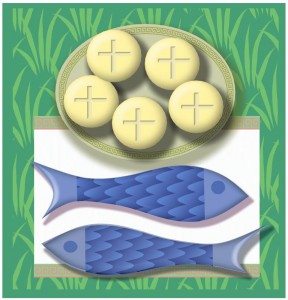John 6:1-21
This text is used for the Lectionary Year B on July 26, 2015.

The focus of 6:1-21 revolves around two signs, feeding of the 5,000 (6:1-15) and walking on water (6:16-21). Both of these occur in the context of the nearness of the Passover (v. 4). This festival allusion is significant because these two signs highlight eating and water, both of which are critical elements in the celebration of the Passover. The Passover centers on a meal representing God’s liberation of the Israelites via the water of the Red Sea.
These two signs are signs number four and five out of seven signs that occur in John between chapters 2 through 11. The themes and motifs contained in these verses echo previous episodes and anticipate coming events. For the writer of John, signs point beyond themselves to something greater. That something greater is Jesus send from God. Unfortunately, often when individuals or groups in John encounter signs they become preoccupied with the miracle itself and miss the Sign-Maker. In both instances of Jesus’ signs in 6:1-21, the crowds and the disciples miss the implications.
This fourth sign in John is the feeding of 5,000 folks. While the Gospel of John is often considered the maverick Gospel because its presentation of Jesus is so radically different than the Synoptics, this particular narrative is found in parallel form in all four Gospels (Matt. 14:13-21; Mark 6:32-44; and Luke 9:10-17), which speaks to its importance for understanding Jesus’ words, actions, and identity. By studying the Gospels together, one is able to tease out some of the unique theological emphases John’s Gospel brings to this scene.
John’s Gospel throws a light more on particular individuals in the feeding. For example, Philip, who is mentioned throughout the Gospel (1:43-48; 12:21-22; and 14:8-9), is specifically challenged to strategize on a way to feed the crowd. Two aspects of Jesus are revealed in this brief scene. First, Jesus often asks challenging questions of individuals and challenging question are frequently put to Jesus, such as, “But what are they [the loaves and fish] among so many people?” (v. 9). Second, Jesus already knows the answer to the questions: “for he himself knew what he was going to do” (v. 6). In John’s Gospel, Jesus is always presented as in control of all situations.
While casual interpreters often read the boy with the barley loaves and two fish into the Synoptic accounts, he is only mentioned in John’s Gospel. This inclusion presents a sense of personal intimacy and connection with the food; it was not just any food but that of one particular young boy. This sense of intimacy in the feeding is also highlighted by Jesus’ act of personally feeding the 5,000 people. While in the Synoptics Jesus gives the food to his disciples to distribute, John, in a surrealistic scene, portrays Jesus as personally handing out the food to each of the 5,000 people, “and when he had given thanks, he [Jesus] distributed them [bread and fish] to those who were seated” (v. 11).
This intimate connection of Jesus himself giving the bread and fish may have echoes of the Eucharist/Lord’s Supper. Jesus is giving himself to each person. This perspective is reinforced later when Jesus tells his disciples and others that he is the “Bread of Life” (6:35), and that no one truly has life unless he or she eats “the flesh of the Son of Man and drink his blood” (6:53).
As often happens with signs, the crowd does not see the significance beyond their filled stomachs. Jesus knows they see him as a patron, like a king, who will dole out endless bread. For this reason, Jesus “withdrew again to the mountain by himself” (v. 15). What makes a perfect Messiah is timing, and in John’s Gospel, while Jesus is clearly presented as king by the author of the Gospel, Jesus will not have kingship defined by others or on their timetable. His kingship will be revealed at the enthronement of the cross when he is “lifted up” (8:28).
The fifth sign, the walking on water (6:15-21), is found in two Gospels (Matt. 14:22-33 and Mark 6:45-52). While John sets the scene at evening like his Gospel writer companions, he adds the extra observation, “It was now dark . . .” (v. 17). John, as is his style, is not so much describing the physical scene as he is presenting a quality of the situation or moment. Darkness in John is the inability to comprehend and know Jesus; the opposite is to be in the light and enlightened. As the disciples illustrate in this scene, and in coming episodes, they are “in the dark.”
In this boat scene, the disciples are on the sea with the wind blowing, and they see Jesus walking on the water coming towards them. They were terrified (v. 19). This experience is the burning bush moment for the disciples. They encounter a theophany, for who can control the waves and sea except the one who created them. God is in their midst, and the typical response is terror. This theophanic experience is reinforced by the words Jesus speaks to the disciples. “It is I; do not be afraid” (v. 20). The phrase “It is I” is the Greek phrase egō eimi, “I am.” This phrase echoes God’s words to Moses at the burning bush (Exodus 3:14).
Many features in these two signs provide suggestions for points of connections for the minister. The reflection on Jesus distributing the bread and fish calls to mind the intimacy of the Lord’s Supper as being that which connects us closely to Jesus. It is not just a ritual reserved and distant but intimate and close.
The disciples and their “Burning Bush” experience is a reminder that revelatory encounters with God ever abound, even when and where one least expects it. The great question is whether we recognize these experiences when we have them, or will fear, social convention, or other interruptions, cause us to miss them.
In a rather strange ending scene (v. 21), the disciples attempt to take Jesus into the boat, and yet in that moment, Jesus, the disciples and boat are instantly at land. As the disciples and crowds learned, you cannot contain Jesus. Every box, every expectation one places upon Jesus is always broken. Jesus is ever anew revealing insights that challenge expectations and norms.
Dr. David M. May
Professor of New Testament
Central Baptist Theological Seminary, Shawnee, KS
dmay@cbts.edu
Tags: feeding 5000, walking on water, Lord’s Supper, theophany

